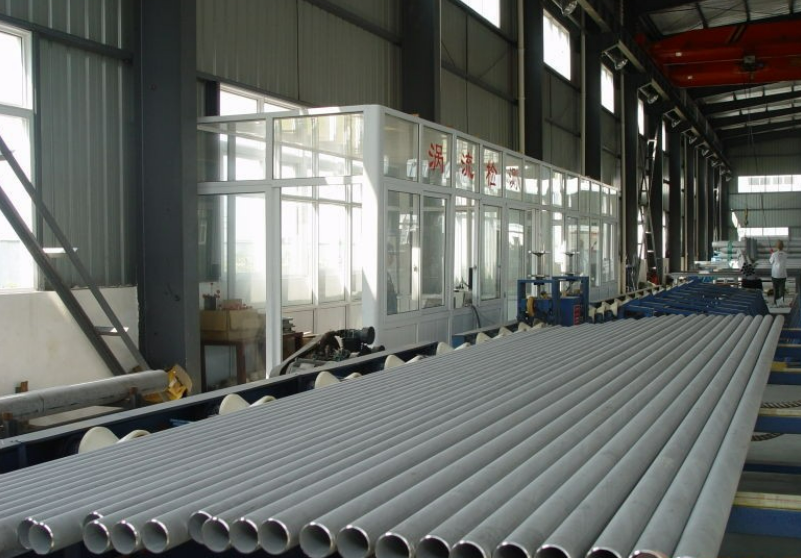Seamless stainless steel pipes are made by piercing steel ingots or solid pipe billets into rough pipes and then rolling, cold rolling or cold drawing. The specifications of seamless steel pipes are expressed by the outer diameter and wall thickness in millimeters. There is a large difference in the manufacturing processes of cold-rolled and hot-rolled stainless steel pipes. This article first introduces the production process of hot-rolled stainless steel pipes.

The Production Process of Hot-rolled Stainless Steel Pipes:
The general production process of hot-rolled stainless steel pipes mainly includes the following steps:
- Round billet → heating → piercing → three-roll skew rolling, continuous rolling or extrusion → strip off → sizing (or reducing) → cooling → billet → straightening → water pressure test (or flaw detection) → marking → storage
In this process, the round billet is the raw material for rolling stainless steel seamless pipes. It needs to be cut into a billet about 1 meter long by a cutting machine and conveyed to the furnace for heating. The heating temperature of the billet in the furnace is about 1200°, and the fuel is acetylene or hydrogen. The key to this step is to control the temperature in the furnace.
After the round billet leaves the furnace, it will be pierced by a pressure-piercing machine. The piercing machine is generally a conical roller piercing machine, which has high production efficiency, good product quality, large piercing expansion, and can pierce various types of steel. After piercing, the round billet is rolled by three-roll skew rolling, continuous rolling or extrusion.
After extrusion, the billet is stripped and sized. The sizing machine drills holes in the steel billet by high-speed rotation of a conical drill bit to form a steel pipe. The inner diameter of the steel pipe is determined by the outer diameter of the drill bit of the sizing machine. After sizing, the steel pipe is cooled in a cooling tower by spraying water and then straightened.
After straightening, the stainless steel pipe is directly conveyed to a metal flaw detection machine for internal inspection. This step mainly detects whether there are cracks or bubbles in the stainless steel pipe. After that, more stringent manual selection is carried out. After the final quality inspection, the stainless steel pipe will be marked with production serial numbers, batch numbers, specifications, etc., and finally stored in the warehouse.
Application Fields of Hot-rolled Stainless Steel Pipes:
Hot-rolled stainless steel pipes have excellent corrosion resistance, high-temperature resistance, strength, and aesthetics, and are widely used in various industries. The following are some common application areas:
- Petrochemical industry: used to transport various corrosive media, high-temperature and high-pressure gases and liquids, such as pipelines, heat exchangers, reactors, and storage tanks.
- Food, pharmaceutical, and medical industries: used to transport high-purity media, such as pure water, pharmaceutical raw materials, food ingredients, and high-pressure oxygen.
- Construction and decoration industry: used for making stairs, guardrails, doors and windows, indoor decoration, etc.
- Automotive and machinery manufacturing industry: used for making automotive exhaust pipes, engine intake manifolds, mechanical structures, etc.
- Energy industry: used to transport natural gas, oil, water and other media.
- Metallurgical, shipbuilding, aerospace and other industries: used for making various pipelines, mechanical structures, etc.
- Water supply and drainage pipes: widely used in drinking water collection and transportation and drainage of industrial wastewater, domestic sewage and rainwater pipelines.
- Direct drinking water supply pipes: With the gradual improvement of people’s quality requirements for drinking water, stainless steel water pipes are widely used in water purification stations to directly provide high-quality drinking water for people.
- Fire protection pipes: stainless steel pipes are commonly used materials for fire sprinkler systems after automatic alarm activation. They can effectively control initial fires and reduce fire safety hazards.
- Urban heating: Most of the floor heating systems used in urban heating mainly use stainless steel water pipes to meet the increasing comfort requirements of modern residents.
- Electricity: The inner wall of stainless steel pipes is smooth, with low water resistance and capable of withstanding high water flow velocities. They are mainly used in equipment such as heaters, boilers, heat exchangers, condensers, etc.
- Pulp transportation and wastewater discharge: During production, stainless steel pipes are also commonly used in pulp transportation and wastewater discharge areas.
- Other areas: During production, many other areas such as pulp transportation and wastewater discharge also often use stainless steel pipes.
Conclusion
Thank you for reading our article and we hope it can help you to have a better understanding of the production process of hot-rolled stainless steel pipes. If you want to learn more about stainless steel pipes, we’d advise you to visit Sino Stainless Steel for more information.
As a leading supplier of stainless steel products across the world, Sino Stainless Steel provides customers with high-quality stainless steel products such as stainless steel strips, stainless steel coils, stainless steel plates, stainless steel sheets, stainless steel bars, and stainless steel tubes at a very competitive price.
 :+86-13012867759
:+86-13012867759  :export86@sino-stainless-steel.com
:export86@sino-stainless-steel.com